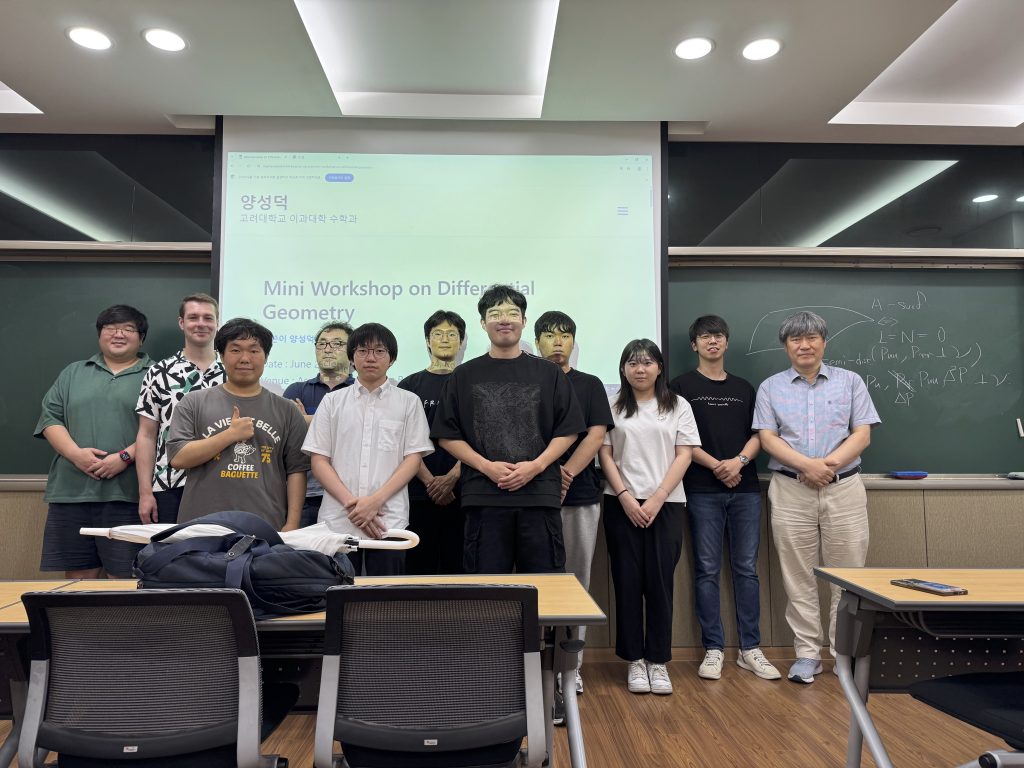Date : June 25, 2025
Venue : Asan Science Building Room 524, Korea University, Seoul.
Inquiry : Email to Seong-Deog Yang at sdyang(at)korea.ac.kr.
Time : 2025/6/25/ 1:30~2:00
Registration
Time : 2025/6/25 2:00-2:30
Speaker : Masaya Hara (Graduate Student at Kobe University)
Title : Simple ends of zero mean curvature surfaces
Abstract : Weierstrass-type representations exist for zero mean curvature surfaces in the Euclidean, Minkowski, and isotropic three-dimensional spaces.
In 2004, Imaizumi introduced the notion of simple ends of maximal surfaces—analogous to planar or catenoidal ends of minimal surfaces—and provided their classification.
In this talk, we first review his classification, then extend the discussion to isotropic 3-space, where we carry out a parallel analysis and complete the classification in this setting.
This work is based on joint research with , J. Cho, A. Honda, T. Raujouan and W. Rossman.
Time : 2025/6/25 3:00-3:30
Speaker : Kyobeom Song (Graduate Student at Rutgers University)
Title : Characterization of Zoll Manifolds via Algebraization
Abstract: A manifold is called Zoll if all geodesics are periodic with
the same period (e.g. a round sphere). The classification of Zoll
manifolds is a longstanding problem, originating in the late 19th
century. Under the assumption that the tangent bundle
can be suitably complexified (i.e. entire Grauert tube), this problem
can be approached via Complex Algebraic Geometry. As an application of
this perspective, we prove that a Zoll manifold with the cohomology
of complex projective space with an entire Grauert
tube must be the Fubini-Study metric. This talk is based on joint work
with Professor Chi Li.
Time : 2025/6/25 4:00- 4:45
Speaker : Philipp Kaese (PostDoc, Kobe University/Technical University of Darmstadt)
Title : A new family of CMC surfaces in homogeneous spaces
Abstract : In 1841 Delaunay characterized surfaces of constant mean curvature H=1 in Euclidean 3-space invariant under rotation. This result was generalized by several authors to screw-motion invariant CMC surfaces in E(k,t), but it turns out that the classification is not complete. In fact, new (embedded) CMC surfaces arise in addition to the Delaunay family. In this talk I would like to talk about these new surfaces and present a complete classification of screw motion CMC surfaces in E(k,t).
Time : 2025/6/25 5:00- 5:30
Speaker : Masashi Yasumoto (Associate Professor at Tokushima University)
Title : Semi-dicrete K-surfaces revisit
Abstract: Because the sine-Gordon equation arises as the integrability condition for surfaces with constant negative Gaussian curvature in the Euclidean space (called K-surfaces), such surfaces have long been central to the interaction between differential geometry and integrable systems. In a similar vein, it is natural to expect the existence of discrete geometric objects corresponding to discrete integrable systems. Bobenko and Pinkall developed a theory of discrete K-surfaces and showed that the discrete sine-Gordon equation, in the sense of Hirota, can be derived as the compatibility condition for these discrete surfaces.
In this talk, we focus on semi-discrete K-surfaces. Mimicking the pioneering work of Bobenko and Pinkall, Wallner formulated semi-discrete K-surfaces based on a natural geometric description. However, their connections to semi-discrete integrable systems have not been thoroughly explored. Recently, we have shown that all such geometric descriptions of semi-discrete K-surfaces can be interpreted as (geometric) Bäcklund transformations of space curves with constant nonzero torsion. As an application, we derive an integrable transformation that produces a new solution to the semi-discrete sine-Gordon equation, in the sense of Orfanidis, from a given one.
Dinner : 6:00 ~
Place : 두부촌맷돌할매숨두부
